Souvenir de DALAT, a set by manhhai on Flickr.
Thứ Ba, 23 tháng 4, 2013
Thứ Tư, 17 tháng 4, 2013
Built on Steep Slopes
Homes Built on Steep Slopes
Feng Shui Solution - Living On A Slope

There are different ways of assessing the feng shui of homes built along hillsides. In cities such as Hong Kong, where so much of the population live in high rise buildings along Mid-levels or on the peak, feng shui Masters expend considerable energies determining which of the formulas of feng shui best apply.
In many other cities, as urban populations grow, hillside living has become increasingly popular, hence many who live in San Francisco, Los Angeles and here in Kuala Lumpur are sometimes confronted with dilemmas when it comes to determining the facing directions of their homes. Lillian Too addresses the feng shui implications of building and living on sloped land.
If you drive along some of the more popular housing suburbs of Kuala Lumpur - Bukit Tunku, Damansara Heights, Pantai Hills - where some incredibly beautiful bungalows, mansions and even condominiums have been built, you will see that many of these houses stand on rather steep slopes. Some have hanging gardens that thrust outwards held aloft by strong concrete pillars; others hug the slopes according to the contours of the land.
Homes built on slopes usually have to decide how high to build and also how low to go. Those lucky enough to have the means to build a home comprising several levels usually build both upwards and downwards from the road level and this brings balanced feng shui; but for those on a tight budget, building downwards is often the preferred option, simply because this is usually a less expensive option.
Here are some golden rules that are helpful to bear in mind when looking at the feng shui perspective of living on sloped land...

1.
Note that it is never ever lucky to live below the road level. This means that if your land is sloped downwards, you must try to either raise the land to at least road level OR build the house in such a way that at least all the main bedrooms are located above road level. The living areas and kitchens can be below road level but the sleeping area should be above road level. This is a very important point to take note of. When you live below road level, the danger of becoming the victim of financial scams or of becoming bankrupt is always a threat and when your astrological energies are low, that is when the chi energy can get negative, causing you to suffer from a sudden reversal of fortune. Living below road level can also cause severe illness or accidents to occur.
The solution for such homes is to raise the energy and create at least a floor that is above road level to house the bedrooms. It is perfectly fine having basements, but it is not auspicious to sleep there if you are the master or mistress of the house. The basement is fine for the household help or maids but not for the master or mistress.

2.
When there are two roads, one at the top and another at the bottom of the slope, and your house can be accessed from both roads, it is much better to enter the house from the bottom road. This makes the whole house higher than the road. It is much better to drive upwards entering the home (and hence drive down when leaving the house) than the other way around. When the house is above road level, it is always more auspicious!
3.
If yours is an apartment within a building that has access from two roads, one at the top and the other below, then the building height should be higher than the top road. This makes the building very lucky for residents and is auspicious because having access from the energy of two roads doubles the luck. In fact, such apartment buildings are rather rare, but where it occurs, you will find that residents within enjoy good feng shui.
4.
When your house is built along a hillside, being in mid levels is better than being right at the peak. And when you are on mid levels, try to let the higher road seem to roll into your entrance. What you want is to ensure that when it rains and water flows along the road, it seems to flow towards your entrance rather than away from you. This is what brings you good luck. So when there is a public road in front of your entrance, try to make sure rain water can indeed flow along the road towards you. If instead there is a road going upwards towards your entrance placed on a higher level, then the effect is that water from your house then flows downwards away from you. This is a less desirable option.

5.
If your house is built on a ridge and there are roads in front and behind the house, it can be quite unlucky as the house is deemed to be exposed to the elements. The danger becomes acute if there is a drop or a slope right behind the house. So try not to live on a ridge with no support behind you as this is very dangerous. To correct this, build a solid looking and high wall behind the house.
6.
To determine the facing direction of a house built along a hillside slope, look at the design of the house façade and see where the main door is facing. Although this does not necessarily mean that the door facing direction is the facing direction of the house. We also need to see if the house is actually facing into a valley, or if there is a picture window or balcony which is directly facing a major source of precious yang energy. Usually, if this is the case, the entrance door which can look like a main door is actually the back of the house.
There are no definitive rules here as to how one can categorically say which is the facing direction, as on-site investigation is usually required. Sometimes even the on-site cannot give a clear cut answer or judgment, in which case the best approach is to use two possible facing directions and undertake analysis using both directions and then see which generates the more accurate information on the history of residents.

7.
If there is higher land behind your house, this always provides support for the home, even when it is built on downward sloping land. This is like living in a valley. As long as the road in front of you is lower than the house itself, or is at least level to the house, the feng shui stays positive.

8.
In the case of those living in apartments, usually the facing direction of the entire building is taken to be the facing direction for purposes of examining the feng shui charts affecting residents within. However, generally for those living in the upper levels and who have a view, then the direction facing the view is often taken to be the facing direction, especially if there is a large open window and there are breezes coming from the windows. Then it is obvious that benevolent
chi energy is coming in from that direction.
http://www.wofs.com/index.php?option=com_content&view=article&id=710:feng-shui-solution-living-on-a-slope&catid=28:fs-fine-points&Itemid=46
Hillside Projects in Malaysia can go on until next Landslide?!
Since the Bukit Antarabangsa landslide killed
five people in December 2008, and forced thousands to evacuate, the
future of hillside projects has been the most controversial topic in
Malaysia. Last week, Works Minister Datuk Seri Mohd Zin Mohamed
announced that "there will be no blanket ban on such projects, because
the country’s population was increasing and land was needed for
development," according to the Star.
He stressed that a total ban would be a waste of land, and proposed
instead an immediate halt on the “tip fill” technique during
construction at hillslopes. (The technique involves "the cutting of
slopes, and removal and refill of soil.") The minister said that with a
ban on the “tip fill” technique, the Highland Towers and
Bukit Antarabangsa tragedies would not recur. He also added that
"development on hill sides should only be carried out on properly
engineered slopes and under strict supervision and maintenance."

This announcement was met with criticism from the Malaysian Bar Council. In a press release, council president Datuk S. Ambiga said "it was deeply concerned with the announcement by Works Minister Datuk Seri Mohd Zin Mohamed that there would not be a blanket ban on hillside development. It is particularly alarming that this statement has been issued at a time when the many controversies surrounding hillside development still remain unresolved, without proper explanation by the authorities.”

The Bar Council says "all hillside development on gradients exceeding 25 degrees should be banned until proper laws are passed.”
The
task force appointed by the Bar Council in December to find solutions
to prevent or minimise future landslides in or around hillslope
developments issued a report saying that “all hillside development on
gradients exceeding 25 degrees should be banned until proper laws are
passed.” The report also identified the main causes of landslides such
as "the lack of competent expertise in design, construction, site
supervision and maintenance and communication during the construction
process."

Is it safe?
http://landslides-gib.blogspot.com/2009/02/hillside-projects-in-malaysia-can-go-on.html
 The
author of the last image says "I just moved back from KL to my own
house in Batu Ferringhi and each time I pass those hill slope
development projects, I can only think of human greed and the stupidity
of the previous state government for approving these projects. I do not
know what to make of these projects but the muddy sea water tells me all
is not right."
The
author of the last image says "I just moved back from KL to my own
house in Batu Ferringhi and each time I pass those hill slope
development projects, I can only think of human greed and the stupidity
of the previous state government for approving these projects. I do not
know what to make of these projects but the muddy sea water tells me all
is not right."
http://landslides-gib.blogspot.com/2008/12/what-are-causes-of-landslides-in.html
 According to the Star,
the tragedy happened following several days of continuous heavy
downpour that apparently loosened the earth on the 200-metre hill. The
two men, who lived in a small concrete hut at the foot of the hill, were
buried by the landslide.
According to the Star,
the tragedy happened following several days of continuous heavy
downpour that apparently loosened the earth on the 200-metre hill. The
two men, who lived in a small concrete hut at the foot of the hill, were
buried by the landslide.
 Houses behind the landslide area are in a precarious situation and the residents have been asked to evacuate. – NST picture.
Houses behind the landslide area are in a precarious situation and the residents have been asked to evacuate. – NST picture.
As the heavy rain may continue in various parts of the state, the threat of more landslides remains. Residents living near hill slopes and other risky areas were warned to be on the constant alert for similar dangers, the Star said.
http://landslides-gib.blogspot.com/2009/01/why-are-there-so-many-landslides-in.html

 Figure
1. Just stop it: Tractors and heavy machinery at work at the site of
the Bukit Ceylon apartment project with danger lurking above. The Sun
OnLine.
Figure
1. Just stop it: Tractors and heavy machinery at work at the site of
the Bukit Ceylon apartment project with danger lurking above. The Sun
OnLine.
 Figure
2. Landslide in Hong Kong. Like in Malaysia, it is common to have
residential buildings constructed at steep slopes and highway located
very close to slopes, because of the scarcity of flatland. From A.K.L. Kwonga, M. Wangb, C.F. Leea, and K.T. Law (2004). Engineering Geology.
Figure
2. Landslide in Hong Kong. Like in Malaysia, it is common to have
residential buildings constructed at steep slopes and highway located
very close to slopes, because of the scarcity of flatland. From A.K.L. Kwonga, M. Wangb, C.F. Leea, and K.T. Law (2004). Engineering Geology.
http://landslides-gib.blogspot.com/2009/02/hillside-projects-in-malaysia-can-go-on.html
What Causes Landslides in Malaysia?
Although Malaysia is not a mountainous country
(mountains and hills are less than 25% of the territory), slope failures
are a common phenomenon there. According to The Sun OnLine,
there have already been a number of landslides only this year. So, why
is this natural disaster so common in the country? I have come up with
some answer, that is, a list of major landslide causes. You can correct
me or add some causes to the list. Here it is:
1. Weathering.
In tropical countries like Malaysia, weathering is always a cause. The
weathering agents are: 1) changes in the daily temperature from 23
degrees (C) to 35 degrees. 2) Rainfall, which is also the major trigger.
There are two rainy seasons in Malaysia: from April to October (the
south-west monsoons), and from October to February (the north-east
monsoons). The average annual rainfall is more than 250 cm.
2. Soil Properties. Due
to the tropical climate and rainfalls, bed rocks are heavily weathered,
resulting in residual soils. This type of soil, which is considered
weak from the geotechnical point of view, is commonly found on hillsides
and slopes. When unsaturated, residual soil has a cohesion due to
suction, however, during rainfall the suction typically drops to zero, a
process that is followed by buildup of excess pore pressures. As a
rainfall continues, the excess pore pressure exceeds a certain
threshold, the strength of soil dramatically drops, and a landslide is
triggered.
3. Human Activities. This
seems to be the major cause of landslides in big cities. Unfortunately,
there is no geotechnical control over slope development works all the
time, and some construction firms don't seem to observe safety standards
for slope engineering practice. As a result, a strong rainfall can
trigger a landslide on such slopes. There are a few pictures to
illustrate the point. I found them in Here’s why Penang should ban hill-slope development.



http://landslides-gib.blogspot.com/2008/12/what-are-causes-of-landslides-in.html
Why are there so many landslides in Malaysia?
Malaysia is a country where landslides are common phenomena. Since December 2008, there have been several landslides,
claiming human lives and causing significant economic loss.
Unfortunately, bad news keeps coming from this country, where another
landslide killed two men in Miri.


As the heavy rain may continue in various parts of the state, the threat of more landslides remains. Residents living near hill slopes and other risky areas were warned to be on the constant alert for similar dangers, the Star said.
http://landslides-gib.blogspot.com/2009/01/why-are-there-so-many-landslides-in.html
Is the Hong Kong's Slope Safety System the Right Choice for Malaysia?

The
latest news is all hillside projects on Class IV slopes – with
gradients above 35° – in Kuala Lumpur, Labuan and Putrajaya have been
banned. According to the government authorities "“Developers of ongoing
projects will be held responsible for carrying out soil stabilising
works and building proper drainage systems to ensure public safety.”

Meanwhile, there have
been some information in the media that the Government may introduce
planning legislation similar to Hong Kong’s guidelines of hillside
development to prevent more landslides in future. Just to remind you, in
1977, the Hong Kong Government established the Geotechnical Engineering
Office, in the aftermath of several catastrophic landslides in the
1970s, to develop slope safety management program. Over the past 30
years, a great amount of work has been done to reduce landslide risk to
the community by exercising geotechnical control of new projects,
maintaining man-made slopes, setting safety standards for slope
engineering practice, promoting public awareness and slope safety
through public education, and providing landslide emergency services.
More information on this topic can be found in Chan and Lau (2008) Slope
Safety System and Landslide Risk Management in Hong Kong.

The
question is "Is it the right choice for Malaysia?" Lets see what the
head of Hong Kong’s Geotechnical Engineering Office (GEO) Raymond Chan
said "Malaysia is very different from Hong Kong, especially where its
laws and geological make-up are concerned. So it is important for the
Government to identify the root problem first. Without proper
identification of the problem, it will be difficult to come up with the
best solution.”
http://landslides-gib.blogspot.com/2008/12/is-hong-kong-slope-safety-system-right.html
http://landslides-gib.blogspot.com/2008/12/is-hong-kong-slope-safety-system-right.html

Larger imageThis hillside home was built on an unbraced tall wall that failed.
Source: Office of Emergency Services
The Problem
Houses built on the sides of steep hills are often set on exposed posts or columns, as shown in the photographs.The potentially hazardous conditions that are unique to homes on steep hillsides are:
- Stilt-type posts with or without diagonal bracing.
- Walls with very different heights or that are stepped or sloped down the hillsides.

Larger imageThis
photograph shows an interior detail of a home similar to the one above,
showing substantial damage to a building with an unbraced tall wall.
Source: Office of Emergency Services
How to Identify
- Is the house located on a slope?
- Are the columns or walls supporting the home braced?
- If you are not sure if there is bracing or if the bracing is adequate, consult a licensed engineer.
Remember
- It is very expensive to lift a house, repair the posts, and put it back.

Larger imageHillside homes with sloped and tall walls or posts require special engineering.
Source: PEER and Nels Roselund, SE
The Solution
Consult a licensed architect or engineer, and a licensed contractor, to fix this problem.How-to Resources
- Detailed information can be found in the International Existing Building Code, published by the International Code Council.
- Voluntary Earthquake Hazard Reduction in Existing Hillside Buildings, City of Los Angeles Municipal Code, Chapter IX, Article 1, Division 94.
Source: California Seismic Safety Commission, Homeowner's Guide to Earthquake Safety (HOG), 2005 edition.
-------------
The following suggestions are intended specifically for siting dwellings on rural land, but most are applicable to other situations and building types (in the Southern Hemisphere, reverse north and south notations).
Don't assume you need a level building site. Often it's best to build on a slope and leave the flattest places for gardening. Slopes can provide the best views and offer advantages in water and air drainage, since gravity will help move water and wastes. Excavating a flat pad on a sloped site can provide earth for building, gardening, or landscaping. On the other hand, very steep slopes may complicate access, require excessive digging, and be difficult to get around on during building.

Aspect
The direction a sloped site faces makes a big difference in ground temperature. South-facing slopes, with their surface more nearly perpendicular to the rays of the winter sun, collect more heat in the winter, which could translate into substantial energy savings.
Drainage
If possible, pick a naturally well-drained site. It will save you work, expense, materials, and repairs. Avoid marshy areas, flood plains, and depressions. Stay away from seasonal creeks and gullies where surface water may flow only during part of the year (or maybe only once every several years). If you can't be on site during the heaviest rainfall of the year, imagine a storm of Biblical proportions and figure out where the water would flow. If you're stuck with a poorly drained clay soil and a rainy climate, put the building on a slope so that you can create artificial drainage.

Subsurface Geology
One of the first things I do when exploring a potential building site is to dig a lot of holes. I want to know how far down it is to bedrock (which will inform my excavation plans and foundation design), how much topsoil there is, and what kinds of amendments the soil needs for building with. If the site has deep, rich topsoil, then it might be better used for a garden or orchard. I also look for evidence of landslides and try to determine whether the site is seismically stable.
In any climate, you can save a lot of money and energy in heating and/or cooling your home by using simple passive solar design strategies. Where winter heating is needed, windows on the south side (or an attached greenhouse) make a big difference but only if you have winter sun on the building! The best sites for passive solar heating (and for photovoltaic electricity) have an unobstructed view to the horizon from the southeast to the southwest. If trees to the south shade your site, consider respectfully harvesting or substantially pruning them. The number of trees you will save by decreased heating needs over the lifetime of the building can easily make up for the ones you take now.
Shade
In hot summer climates, afternoon shading can make the difference between a cool, comfortable retreat and an oven. Look for tall trees to the southwest and west of the site. Deciduous trees are especially useful since they block the summer sun but drop their leaves and let the winter sun through. In general, trees and vegetation around a site will keep it cooler and moister. Deciduous trees and vines can also be planted after the structure is complete.
Prevailing Wind Direction
Because of local topography, wind direction on a specific site can very enormously from the regional norm. Find out from which direction the biggest storms approach your site. (If you live in the woods, look for big fallen trees. Which direction did they fall?) Will there be wind-driven rain, sleet, or snow? Are you in a valley that channels cold winds past your site, increasing your future heating costs? Are you on a ridge with a spectacular view of the ocean but no protection from whipping gales?
Air Drainage
On clear winter nights, air cools off and condenses wherever it is exposed to the sky, flowing downhill like a viscous fluid. Wherever its passage is blocked by a rise in the ground, a line of trees, or even a building, it comes to rest, creating 'frost pockets' of much colder air. These are the places that freeze first — not a good location for your tomatoes or a cozy home. Valley floors are often the worst. If your site is on a slope, then make sure that cold air can drain away downhill. Also position your buildings where early morning winter sun will warm them up sooner.
Fire
Wildfire runs uphill and in the direction of the wind. Ridges and hilltops are the most susceptible to burning. Waterways, roads, and irrigated gardens all make effective firebreaks.
Floods
If you're near a river or stream, find out where the 100-year flood plain is and site any buildings beyond its reach. Get to know old-timers in your area and ask them about the most extreme weather conditions they can remember.
It's incredibly useful to have a good understanding of overall land usage before you site any building. Look as far into the future as possible. What buildings, gardens, orchards, pastures, ponds, woodlots, and wild areas might you eventually want on the land, and where does it make the most sense to put them? How can you position them relative to each other in a sensible way so that each part of the system meets the needs of the others and of the whole system? For example, can you dig a pond to provide earth for your cob house, fire control, and a home for the ducks and geese, which will also help with erosion and drought control, be part of your graywater system, and irrigate your fruit orchard? This sort of design takes thought and careful planning.
Access
Although it's not always necessary to have a permanent road to a building site, it's important to think about these questions: How will you transport materials to the site during construction? How will the inhabitants get themselves, their babies, groceries, and the like to the building in rainy or snowy weather? What about emergencies — getting sick people out or fire engines in? It's very romantic to build on a remote site with no vehicle access. But a few experiences of hauling heavy materials like sand, cement, and foundation stones uphill via wheelbarrow makes me recommend that you seriously consider at least a temporary road, which can be decommissioned or shortened after construction is complete. If you do create a new permanent road, then plan it very carefully.

Water and Utilities
Drinking water, wash water, electricity, phone lines — if you need them, where will they come from? Avoid having to pump sewage uphill to a septic system or leach field. Plan for your graywater to be useful downhill from the building site in an orchard, garden, woodlot, or pond. Wastewater considerations suggest that it may be best to avoid locating your home at the lowest point of the property.
Building Materials
If you plan to use materials from the land (such as earth, sand, stones, trees, straw , or water) in construction, where are they located and how will you transport them? It's much easier to roll stones downhill than up.
Different counties have different land use policies and varying abilities to enforce them. Within a county, areas are zoned for different purposes, such as residential, forestry, or light industry. If your plans include agriculture, manufacturing, multiple residences, or building with alternative materials and you pick the wrong location, then you may find yourself fighting your neighbors and the county government. Neighbor relations are of primary importance, so nurture them. Try to find an area where other people are doing the sorts of things you would like to do. Zoning and regulatory considerations should affect your choice of a building site on a much larger scale — at neighborhood, county, and state levels.
Privacy
Think about not only visual privacy but also protection from noise, smells, and light pollution. A nearby highway may be loud on one side of the property and impossible to hear just around the side of the hill. Some kinds of noise and smells (hunting, field burning, etc.) are seasonal. If you want to keep a low profile, then figure out where your building site is visible from. Can it be seen from a neighbor's property, a driveway, or a major highway? Remember that visibility can be much greater in winter when some trees drop their leaves.

Community
Would you like your home to be clustered near friends and neighbors for mutual support, safety, and companionship?
Easements
Owning the title to a piece of land doesn't mean that you own all the rights to it. A neighbor might already have permission to put a road through your property. The phone or utility company may own a corridor where they plan to put a cable or pipeline. A mining company may own the mineral rights to your land, allowing them to drill or tunnel beneath the surface. These rights are called 'easements,' and should be recorded on the property title.
Future Development
Find out who owns surrounding land and what they plan to do with it. Clearcut the forest? Build a housing development? Get to know your neighbors and ask them what rumors they've heard. Also check with your county planning department to find out about their plans to widen roads or change the zoning.
Although you can establish beautiful short views by landscaping your site, you can't do much about the long views. Either you have them or you don't. Views of the sky and the distant horizon do a lot to combat feelings of claustrophobia and cabin fever, especially for people who live in the forest or in places with cold or gray winters, or for those who spend a lot of time at home. Sometimes you can open up long views by judiciously pruning or clearing trees around your site.
 History
It's
always useful to know what human beings before you have done on the
land. Who were the original human inhabitants of this place? Are there
sites of archeological or religious significance that it would be
better not to disturb? In recent times, have people used chemicals that
might still be present in the soil and water? If there's a history of
manufacturing, agriculture, or even previous building, it might be a
good idea to get the soil tested for toxins.
History
It's
always useful to know what human beings before you have done on the
land. Who were the original human inhabitants of this place? Are there
sites of archeological or religious significance that it would be
better not to disturb? In recent times, have people used chemicals that
might still be present in the soil and water? If there's a history of
manufacturing, agriculture, or even previous building, it might be a
good idea to get the soil tested for toxins.
Ecological Impact
It hardly seems necessary to suggest that you think seriously before cutting down a lot of trees or draining a wetland for your building site. But all outdoors places are habitat. Get to know the plants and animals that you will displace or kill during construction. Find out where deer trails pass through, where owls roost to hunt, and who is living underground. Try to locate your building where it will cause the least disruption to natural cycles. Many people advocate building on the most damaged sites: clearcuts, logging depots, or abandoned pastures. That way, through erosion control, revegetation, and so on, you can actually improve the ecological health of the site.
Feng Shui
The Chinese art of building placement is based on the interrelationships of factors like geometry and subterranean waterways, but you don't have to be a trained specialist to use your intuition. Different places have different kinds of energy. Spend time on a proposed building site, meditating or just living, and see how it feels. Is the energy happy or sad, welcoming or resistant? Would you be comfortable with it in your home? Usually the most magical spots, like that special natural meadow in the back woods, are exactly the places where you should not locate a building. Any intervention changes the feeling of a place, and building a house has an extreme impact. If the place is already as good as it can be leave it alone.
— Michael G. Smith provides consultation to owner-builders on the placement and design of natural buildings.
------------
Of course these guidelines aren't absolute, and sometimes the exceptions are as intriguing as the rules! Nevertheless, I believe that in well-crafted houses that embody most of these principles, small spaces can be intensified to become richer and more enjoyable. A vibrant level of complexity will automatically unfold. And it might just be that houses made in this way will be understood to be a contribution to the well-being of the planet.
Landslides and floods wreaked havoc in the area
At least 95 people have died in the
Brazilian state of Rio de Janeiro after the most torrential rain for
decades caused landslides and flooding.
A state of emergency has been declared and officials have warned the death toll may rise as many more are missing.
At least 33 people died in Rio de Janeiro city after 28cm (11in) of rain fell in 24 hours, while 33 were killed in the neighbouring city of Niteroi.
Many houses in Rio's hillside shanty towns were buried under mudslides.
Rescue teams have been scouring the city's hillsides to find missing people and recover bodies buried under the mud.
With no let-up in the rain, President Luiz Inacio Lula da Silva has urged residents to leave their homes if they are at risk of flooding.
Otherwise, the authorities have told people to stay indoors and avoid travelling around the city.
Chaotic situation
Authorities say the city of Rio de Janeiro's transport system is close to collapse, after traffic ground to a halt with many streets under water.
"The situation is chaos," Mayor Eduardo da Costa Paes said in a
statement on Tuesday. "All the major streets of the city are closed
because of the floods.
"Each and every person who attempts to enter them will be at enormous risk," he warned.
Mr Paes said the preparedness for heavy rainfall in Brazil's second-largest city - which will host the 2014 World Cup and 2016 Olympic Games - was "less than zero".
Public schools will remain closed until at least Friday.
State governor Sergio Cabral meanwhile declared a state of emergency and urged people in high-risk areas to leave their homes.
He told TV Globo that to stay inside would be "irresponsible" given the risk of new landslides.
The victims of shanty town landslides in the city of Rio de Janeiro included a five-month-old baby and a nine-year-old child, officials said.
The continuous rainfall also forced Santos Dumont airport, which handles domestic flights, to close for two hours on Monday night, causing a number of delays.
Many cars were left abandoned on main roads throughout the city.
The head of Rio de Janeiro's civil defence department told TV Globo the amount of rain that had fallen was "more than any city is capable of supporting".
Paulo Marqueiro, a reporter for the newspaper O Globo, told the BBC it was like the city had "collapsed".
Houses had been brought crashing down by the floods and landslides, and there was no public transport whatsoever, he said.
'Pray to God'
BBC News website reader Antonio Queiroz Junior said it had started raining after 1700 (2000 GMT) on Monday, during the rush hour.
"It hasn't stopped raining since then," he said. "This is the worst storm in decades."
He added: "The city has been abandoned by our government. The current situation is unacceptable, with so many people getting killed because of the rain.
"Everybody knows the danger of living in the hills, and the government does nothing to stop more and more people building houses there."
Another reader in Rio de Janeiro, Duncan Crossley, said he had witnessed Rio de Janeiro "on the brink of collapse".
He said the power had been cut in his neighbourhood at about midday, and that the storm had brought down huge trees, which along with the flooding were blocking major traffic arteries.
"The streets were thick with mud," he wrote. "The city reminded me of a war zone."
President Lula, who was visiting the city on Tuesday, blamed local
officials for not enforcing adequate building standards in areas prone
to landslides, particularly in shantytowns.
"All we can do is pray to God to hold back the rains a little, so that Rio can return to normal, and so that we can set about fixing the things in the city that need fixing," he told local radio.
The president said the work would include improved drainage systems.
Rio de Janeiro state has experienced a particularly hot and rainy summer this year, and meteorologists have forecast more rain in the coming days. However, correspondents say heavy rain is more common in January than in April.
In January, at least 39 people were killed by mudslides in the resort area of Angra dos Reis, half way between Rio de Janeiro and Santos.
 http://news.bbc.co.uk/2/hi/americas/8605386.stm
http://news.bbc.co.uk/2/hi/americas/8605386.stm
 Image of Rocinha by Marie Hart
Image of Rocinha by Marie Hart
Dramatic pictures and devastation in Rio de Janeiro following heavy rains.
http://news.bbc.co.uk/2/hi/americas/8437408.stm

 http://www.mediadump.com/hosted-id108-the-most-dangerous-roads-in-the-world.html
HIDE CAPTIONSSTART SLIDESHOW
http://www.mediadump.com/hosted-id108-the-most-dangerous-roads-in-the-world.html
HIDE CAPTIONSSTART SLIDESHOW
-------------
Siting a Natural Building
- — Michael G. Smith
The following suggestions are intended specifically for siting dwellings on rural land, but most are applicable to other situations and building types (in the Southern Hemisphere, reverse north and south notations).
Physical Site Characteristics
SlopeDon't assume you need a level building site. Often it's best to build on a slope and leave the flattest places for gardening. Slopes can provide the best views and offer advantages in water and air drainage, since gravity will help move water and wastes. Excavating a flat pad on a sloped site can provide earth for building, gardening, or landscaping. On the other hand, very steep slopes may complicate access, require excessive digging, and be difficult to get around on during building.

The direction a sloped site faces makes a big difference in ground temperature. South-facing slopes, with their surface more nearly perpendicular to the rays of the winter sun, collect more heat in the winter, which could translate into substantial energy savings.
Drainage
If possible, pick a naturally well-drained site. It will save you work, expense, materials, and repairs. Avoid marshy areas, flood plains, and depressions. Stay away from seasonal creeks and gullies where surface water may flow only during part of the year (or maybe only once every several years). If you can't be on site during the heaviest rainfall of the year, imagine a storm of Biblical proportions and figure out where the water would flow. If you're stuck with a poorly drained clay soil and a rainy climate, put the building on a slope so that you can create artificial drainage.

One of the first things I do when exploring a potential building site is to dig a lot of holes. I want to know how far down it is to bedrock (which will inform my excavation plans and foundation design), how much topsoil there is, and what kinds of amendments the soil needs for building with. If the site has deep, rich topsoil, then it might be better used for a garden or orchard. I also look for evidence of landslides and try to determine whether the site is seismically stable.
Microclimate
Solar AccessIn any climate, you can save a lot of money and energy in heating and/or cooling your home by using simple passive solar design strategies. Where winter heating is needed, windows on the south side (or an attached greenhouse) make a big difference but only if you have winter sun on the building! The best sites for passive solar heating (and for photovoltaic electricity) have an unobstructed view to the horizon from the southeast to the southwest. If trees to the south shade your site, consider respectfully harvesting or substantially pruning them. The number of trees you will save by decreased heating needs over the lifetime of the building can easily make up for the ones you take now.
Shade
In hot summer climates, afternoon shading can make the difference between a cool, comfortable retreat and an oven. Look for tall trees to the southwest and west of the site. Deciduous trees are especially useful since they block the summer sun but drop their leaves and let the winter sun through. In general, trees and vegetation around a site will keep it cooler and moister. Deciduous trees and vines can also be planted after the structure is complete.
Prevailing Wind Direction
Because of local topography, wind direction on a specific site can very enormously from the regional norm. Find out from which direction the biggest storms approach your site. (If you live in the woods, look for big fallen trees. Which direction did they fall?) Will there be wind-driven rain, sleet, or snow? Are you in a valley that channels cold winds past your site, increasing your future heating costs? Are you on a ridge with a spectacular view of the ocean but no protection from whipping gales?
Air Drainage
On clear winter nights, air cools off and condenses wherever it is exposed to the sky, flowing downhill like a viscous fluid. Wherever its passage is blocked by a rise in the ground, a line of trees, or even a building, it comes to rest, creating 'frost pockets' of much colder air. These are the places that freeze first — not a good location for your tomatoes or a cozy home. Valley floors are often the worst. If your site is on a slope, then make sure that cold air can drain away downhill. Also position your buildings where early morning winter sun will warm them up sooner.
Fire
Wildfire runs uphill and in the direction of the wind. Ridges and hilltops are the most susceptible to burning. Waterways, roads, and irrigated gardens all make effective firebreaks.
Floods
If you're near a river or stream, find out where the 100-year flood plain is and site any buildings beyond its reach. Get to know old-timers in your area and ask them about the most extreme weather conditions they can remember.
Site Planning
Master PlanIt's incredibly useful to have a good understanding of overall land usage before you site any building. Look as far into the future as possible. What buildings, gardens, orchards, pastures, ponds, woodlots, and wild areas might you eventually want on the land, and where does it make the most sense to put them? How can you position them relative to each other in a sensible way so that each part of the system meets the needs of the others and of the whole system? For example, can you dig a pond to provide earth for your cob house, fire control, and a home for the ducks and geese, which will also help with erosion and drought control, be part of your graywater system, and irrigate your fruit orchard? This sort of design takes thought and careful planning.
Access
Although it's not always necessary to have a permanent road to a building site, it's important to think about these questions: How will you transport materials to the site during construction? How will the inhabitants get themselves, their babies, groceries, and the like to the building in rainy or snowy weather? What about emergencies — getting sick people out or fire engines in? It's very romantic to build on a remote site with no vehicle access. But a few experiences of hauling heavy materials like sand, cement, and foundation stones uphill via wheelbarrow makes me recommend that you seriously consider at least a temporary road, which can be decommissioned or shortened after construction is complete. If you do create a new permanent road, then plan it very carefully.

Drinking water, wash water, electricity, phone lines — if you need them, where will they come from? Avoid having to pump sewage uphill to a septic system or leach field. Plan for your graywater to be useful downhill from the building site in an orchard, garden, woodlot, or pond. Wastewater considerations suggest that it may be best to avoid locating your home at the lowest point of the property.
Building Materials
If you plan to use materials from the land (such as earth, sand, stones, trees, straw , or water) in construction, where are they located and how will you transport them? It's much easier to roll stones downhill than up.
Social and Political Considerations
Zoning and RegulationsDifferent counties have different land use policies and varying abilities to enforce them. Within a county, areas are zoned for different purposes, such as residential, forestry, or light industry. If your plans include agriculture, manufacturing, multiple residences, or building with alternative materials and you pick the wrong location, then you may find yourself fighting your neighbors and the county government. Neighbor relations are of primary importance, so nurture them. Try to find an area where other people are doing the sorts of things you would like to do. Zoning and regulatory considerations should affect your choice of a building site on a much larger scale — at neighborhood, county, and state levels.
Privacy
Think about not only visual privacy but also protection from noise, smells, and light pollution. A nearby highway may be loud on one side of the property and impossible to hear just around the side of the hill. Some kinds of noise and smells (hunting, field burning, etc.) are seasonal. If you want to keep a low profile, then figure out where your building site is visible from. Can it be seen from a neighbor's property, a driveway, or a major highway? Remember that visibility can be much greater in winter when some trees drop their leaves.

Would you like your home to be clustered near friends and neighbors for mutual support, safety, and companionship?
Easements
Owning the title to a piece of land doesn't mean that you own all the rights to it. A neighbor might already have permission to put a road through your property. The phone or utility company may own a corridor where they plan to put a cable or pipeline. A mining company may own the mineral rights to your land, allowing them to drill or tunnel beneath the surface. These rights are called 'easements,' and should be recorded on the property title.
Future Development
Find out who owns surrounding land and what they plan to do with it. Clearcut the forest? Build a housing development? Get to know your neighbors and ask them what rumors they've heard. Also check with your county planning department to find out about their plans to widen roads or change the zoning.
Other Important Considerations
ViewsAlthough you can establish beautiful short views by landscaping your site, you can't do much about the long views. Either you have them or you don't. Views of the sky and the distant horizon do a lot to combat feelings of claustrophobia and cabin fever, especially for people who live in the forest or in places with cold or gray winters, or for those who spend a lot of time at home. Sometimes you can open up long views by judiciously pruning or clearing trees around your site.

Ecological Impact
It hardly seems necessary to suggest that you think seriously before cutting down a lot of trees or draining a wetland for your building site. But all outdoors places are habitat. Get to know the plants and animals that you will displace or kill during construction. Find out where deer trails pass through, where owls roost to hunt, and who is living underground. Try to locate your building where it will cause the least disruption to natural cycles. Many people advocate building on the most damaged sites: clearcuts, logging depots, or abandoned pastures. That way, through erosion control, revegetation, and so on, you can actually improve the ecological health of the site.
Feng Shui
The Chinese art of building placement is based on the interrelationships of factors like geometry and subterranean waterways, but you don't have to be a trained specialist to use your intuition. Different places have different kinds of energy. Spend time on a proposed building site, meditating or just living, and see how it feels. Is the energy happy or sad, welcoming or resistant? Would you be comfortable with it in your home? Usually the most magical spots, like that special natural meadow in the back woods, are exactly the places where you should not locate a building. Any intervention changes the feeling of a place, and building a house has an extreme impact. If the place is already as good as it can be leave it alone.
— Michael G. Smith provides consultation to owner-builders on the placement and design of natural buildings.
------------
Eighteen Design Principles to Make Square Feet Work Harder
- — Robert Gay
Before you begin designing, do this four-part exercise in self-knowledge.
- Study your lifestyle very carefully.
- Think as freely as possible about the qualities of the spaces and places you have most loved and hated.
- Fight to minimize your clutter and accumulations.
- Free yourself up from advertising, media imagery, and pressures to consume, since if you don't, the urge to buy will terrorize you.
|
   |
Of course these guidelines aren't absolute, and sometimes the exceptions are as intriguing as the rules! Nevertheless, I believe that in well-crafted houses that embody most of these principles, small spaces can be intensified to become richer and more enjoyable. A vibrant level of complexity will automatically unfold. And it might just be that houses made in this way will be understood to be a contribution to the well-being of the planet.
- Robert
Gay, an architect in private practice in Tucson, centers his largely
residential practice on human needs and sustainable building practices,
with a specialty in straw bale design. He's also done university
teaching, a college master plan, general contracting, furniture making,
stonework, and small playful art projects. He lives near the Catalina
Mountains with his wife, two small boys, and many other creatures, some
domesticated.
Flooding in Rio de Janeiro state kills scores
Advertisement
A state of emergency has been declared and officials have warned the death toll may rise as many more are missing.
At least 33 people died in Rio de Janeiro city after 28cm (11in) of rain fell in 24 hours, while 33 were killed in the neighbouring city of Niteroi.
Many houses in Rio's hillside shanty towns were buried under mudslides.
Rescue teams have been scouring the city's hillsides to find missing people and recover bodies buried under the mud.
With no let-up in the rain, President Luiz Inacio Lula da Silva has urged residents to leave their homes if they are at risk of flooding.
Otherwise, the authorities have told people to stay indoors and avoid travelling around the city.
Chaotic situation
Authorities say the city of Rio de Janeiro's transport system is close to collapse, after traffic ground to a halt with many streets under water.
|
ANALYSIS

Paulo Cabral
BBC News, Rio de Janeiro
The rain is not so intense
but the risk of new landslides remains high, as the soil of the
hillsides is extremely wet. Most of those who died were people in the
hillside slums where waves of mud came down destroying everything in
their way.
The topography in Rio exacerbates these types of problems. It's one of the most beautiful cities in the world because of the mountains in the middle of the town, but it can get nasty when it rains. Ten years ago a census found 12,000 people lived in high-risk areas, but there have been new developments since then so the number is probably much higher. |
"Each and every person who attempts to enter them will be at enormous risk," he warned.
Mr Paes said the preparedness for heavy rainfall in Brazil's second-largest city - which will host the 2014 World Cup and 2016 Olympic Games - was "less than zero".
Public schools will remain closed until at least Friday.
State governor Sergio Cabral meanwhile declared a state of emergency and urged people in high-risk areas to leave their homes.
He told TV Globo that to stay inside would be "irresponsible" given the risk of new landslides.
The victims of shanty town landslides in the city of Rio de Janeiro included a five-month-old baby and a nine-year-old child, officials said.
Rio de Janeiro has experienced a particularly hot and rainy summer
Flooding left another 12 people dead in Sao Goncalo, and one in Petropolis. The continuous rainfall also forced Santos Dumont airport, which handles domestic flights, to close for two hours on Monday night, causing a number of delays.
Many cars were left abandoned on main roads throughout the city.
The head of Rio de Janeiro's civil defence department told TV Globo the amount of rain that had fallen was "more than any city is capable of supporting".
Paulo Marqueiro, a reporter for the newspaper O Globo, told the BBC it was like the city had "collapsed".
Houses had been brought crashing down by the floods and landslides, and there was no public transport whatsoever, he said.
'Pray to God'
BBC News website reader Antonio Queiroz Junior said it had started raining after 1700 (2000 GMT) on Monday, during the rush hour.
|
Antonio Queiroz Junior
|
He added: "The city has been abandoned by our government. The current situation is unacceptable, with so many people getting killed because of the rain.
"Everybody knows the danger of living in the hills, and the government does nothing to stop more and more people building houses there."
Another reader in Rio de Janeiro, Duncan Crossley, said he had witnessed Rio de Janeiro "on the brink of collapse".
He said the power had been cut in his neighbourhood at about midday, and that the storm had brought down huge trees, which along with the flooding were blocking major traffic arteries.
"The streets were thick with mud," he wrote. "The city reminded me of a war zone."

Civil defence authorities in Rio have issued an alert for landslides
|
"All we can do is pray to God to hold back the rains a little, so that Rio can return to normal, and so that we can set about fixing the things in the city that need fixing," he told local radio.
The president said the work would include improved drainage systems.
Rio de Janeiro state has experienced a particularly hot and rainy summer this year, and meteorologists have forecast more rain in the coming days. However, correspondents say heavy rain is more common in January than in April.
In January, at least 39 people were killed by mudslides in the resort area of Angra dos Reis, half way between Rio de Janeiro and Santos.

Flooding and landslides in Rio

Geographers
will appreciate the risk that weather like this brings to those people
whose homes are built in marginal locations: steep slopes, land which
was not suitable for other developments and land on river floodplains.
The BBC have been following
the dramatic story, and this would also make a useful context for using
Google Earth in the classroom to navigate to some of the locations
featured in the articles and explore the slopes and the relationships
between the buildings and the terrain.
UPDATE:
The government is beginning to remove settlements which are built in
dangerous locations and thousands of dwellers are facing forced evictions.
http://livinggeography.blogspot.com/2010/04/flooding-and-landslides-in-rio.html
http://livinggeography.blogspot.com/2010/04/flooding-and-landslides-in-rio.html
http://news.bbc.co.uk/2/hi/americas/8437408.stm
In pictures: Brazil's mudslide tragedies


Landslides
triggered by heavy rain in areas around the Brazilian city of Rio de
Janeiro have claimed more than 60 lives. In Morro da Carioca at least 12
people died when a section of hillside gave way.
The Most Dangerous Roads in the World
At
one time or another, most drivers encounter unsafe road conditions.
Hazards can appear in many different forms, for instance, poor weather,
drunk drivers, and simple human error can all complicate an otherwise
uneventful journey. On the other hand, sometimes the condition of the
road itself can put your life in jeopardy.
It is hard to imagine how many dangerous roads there are. When working on this post I studied about few resources to find out that there are over 100 dangerous and scary roads and these are just the most famous we've heard of. There are different factors of danger so it is really hard to say what roads are the most dangerous of all the dangerous roads in the world. But here is our list of most blood-bathing roads and the deadly routes where tonnes of accidents have happened. Do check them out and, more importantly, try to avoid them!
Stelvio Pass Road, Italy
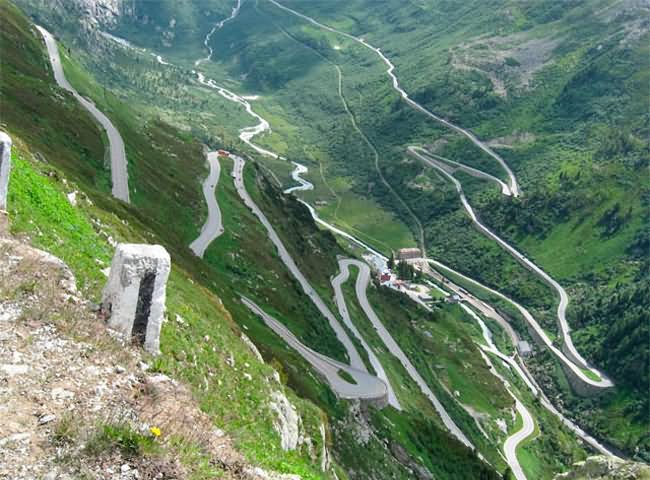
The eastern Alps countryside of Italy are incredibly breathtaking. This zig-zag stretch of road at 1.7 miles above sea level has approximately 48 hairpin bends. It's beautiful to look at from a distance, but wouldn't be easier to fly over the Alps to get to the other side?
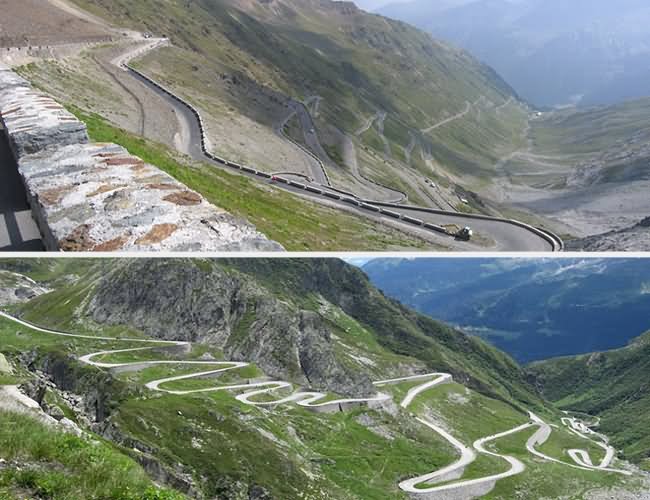
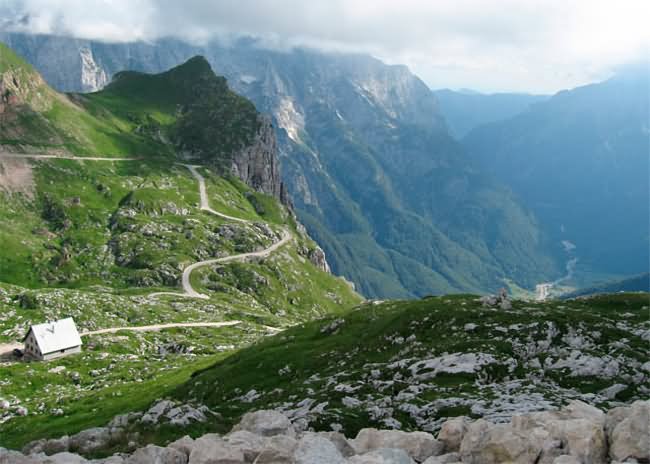
Trollstigen, Norway
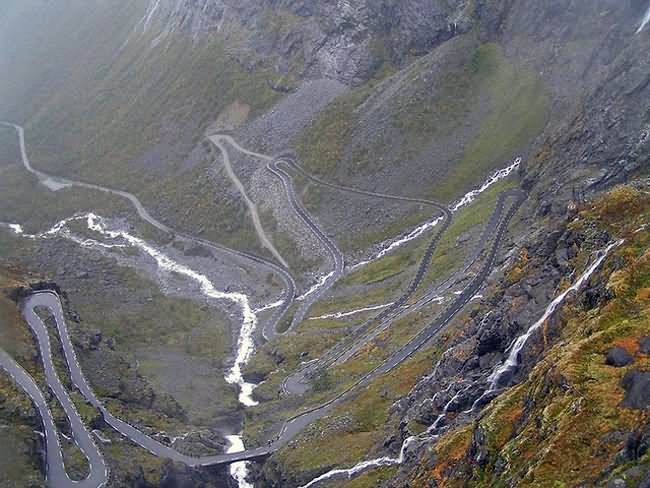
Trollstigen translated means "Troll's Ladder." Dizzy hairpins, almost impossible to pass another car on this narrow road and then put the danger of falling rocks with steep inclines that leave you with a case of vertigo… why oh why drive here? Tourist are attracted by the beautiful 1000ft waterfall off the side of the mountain. You want to see a waterfall, fly to Hawaii. It's safer and you can get a tan.
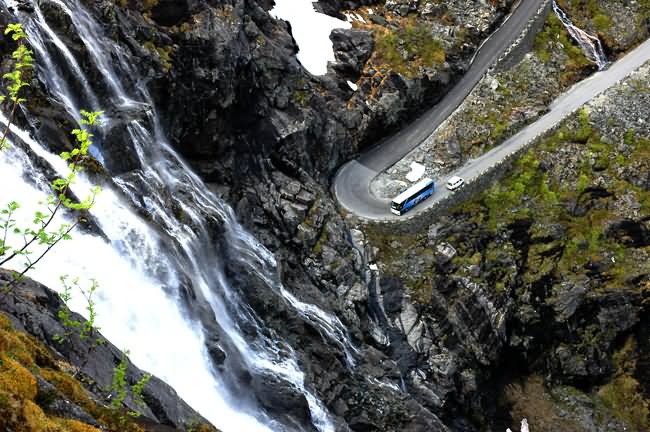
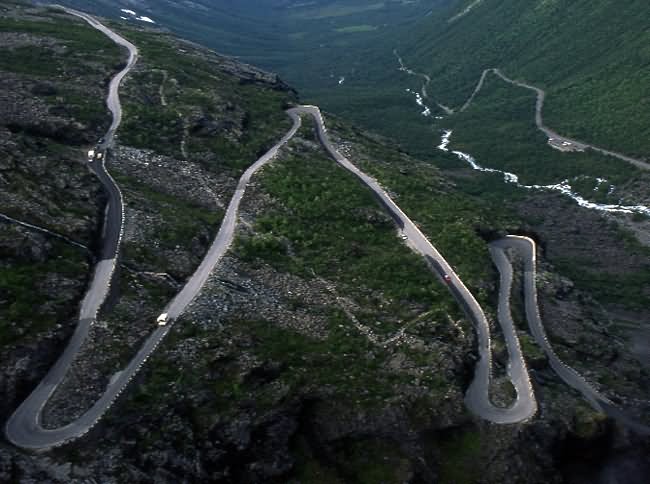
Col de Turini, France
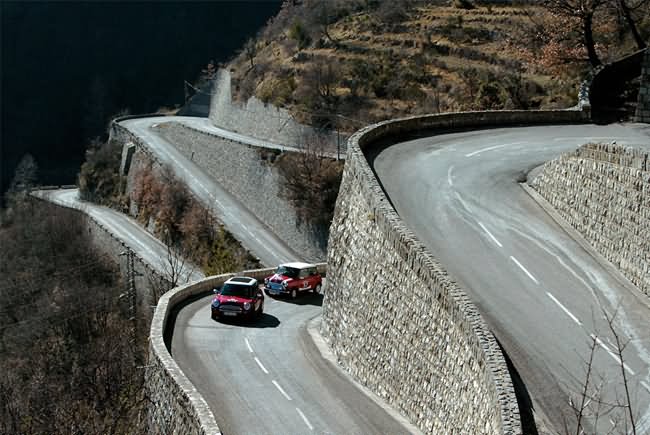
Who doesn't want to go to the south of France? About 20 miles on this pass is part of the Monte Carlo Rally with 34 death defying hairpins and long stretches where cars top our at over 100 miles per hour. It's considered one of the greatest driving roads of the world, but not for normal people who embrace safety first.
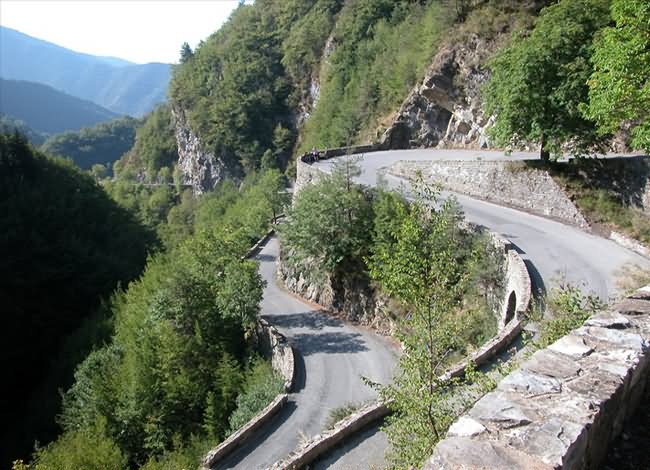
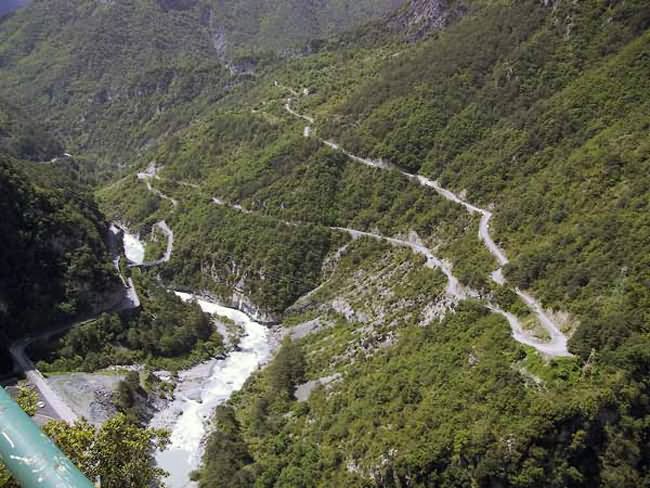
North Yungas Road, Bolivia
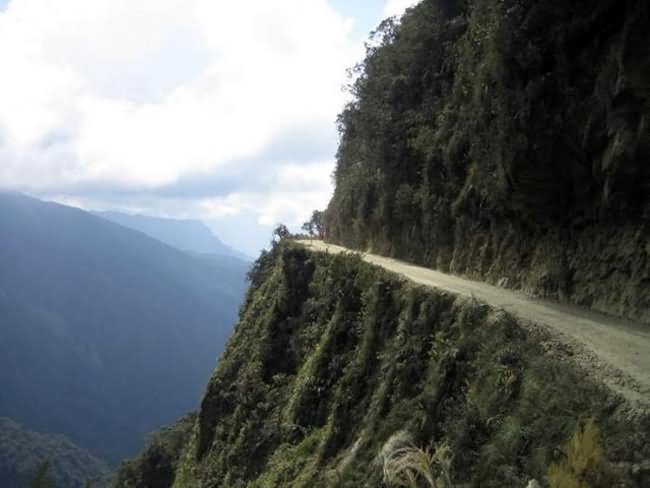
This road is also known as the "Road of Death." It's a single-lane road, so why do these trucks try to pass each other are they nuts? It's a long drop down without guardrails. There's also fog and rain to contend with including mudslides caused by moisture.
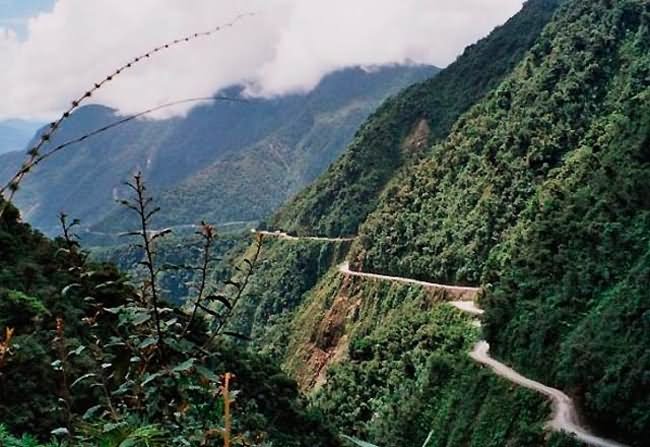
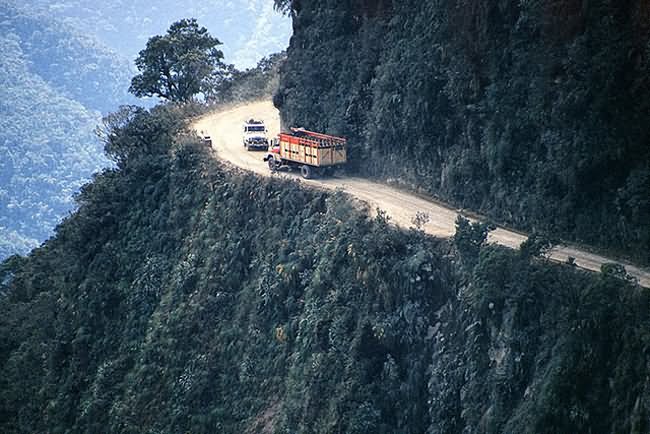
Taroko Gorge Road, Taiwan (Chungheng)
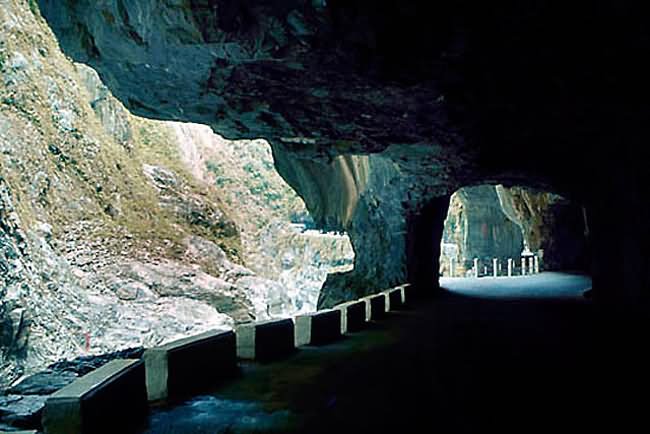
A tunnel with no lights off a cliff equals a disaster waiting to happen. Tourist love it because it passes right through a national park. At least there's a cement guard rail system.
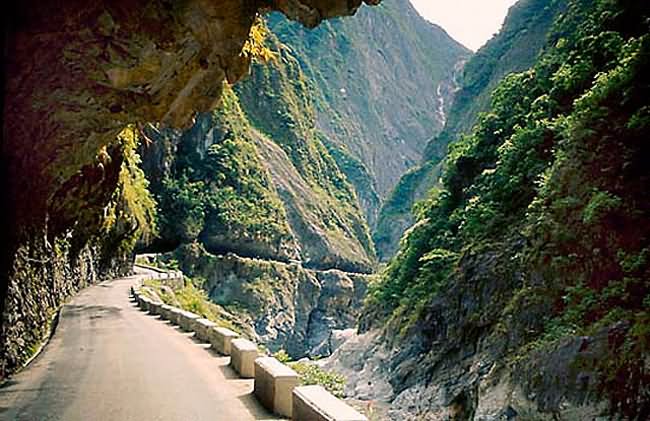
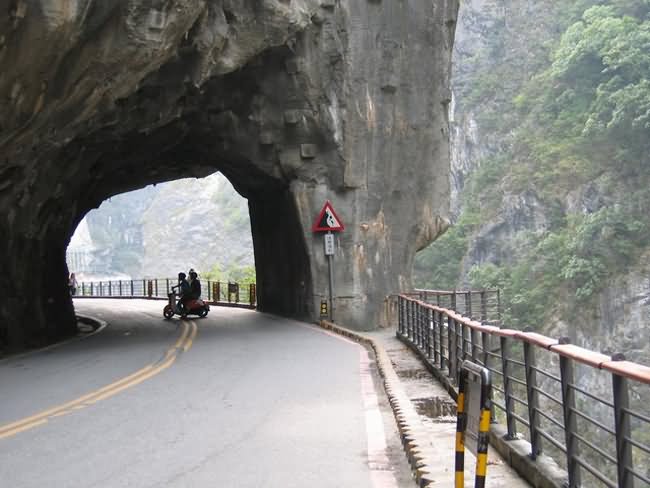
Los Caracoles Pass, Andes
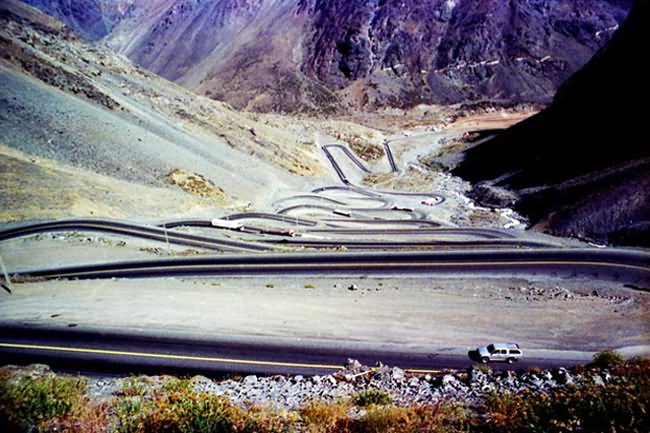
A very popular path through the Andreas Mountains between Chile and Argentina. A maze of steep inclines and hairpins without guard rails and the road is covered with snow for the most part of the year. Buy an airline ticket and fly back and forth between the two countries.
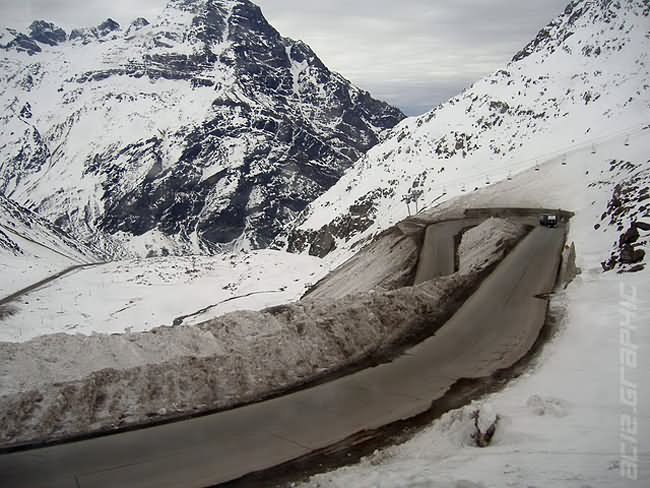
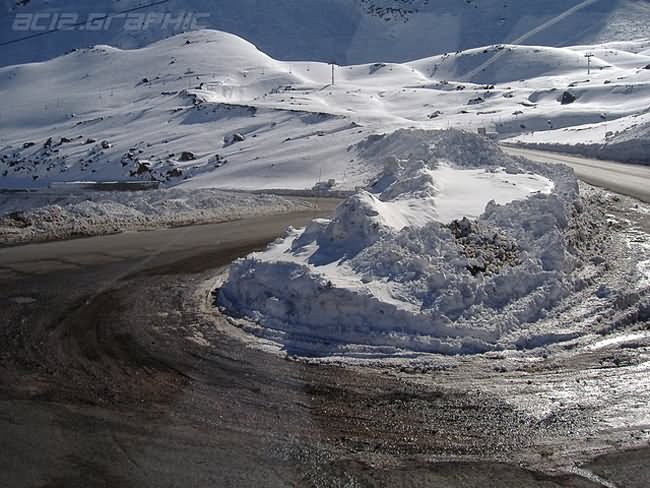
Lena Highway, Russia
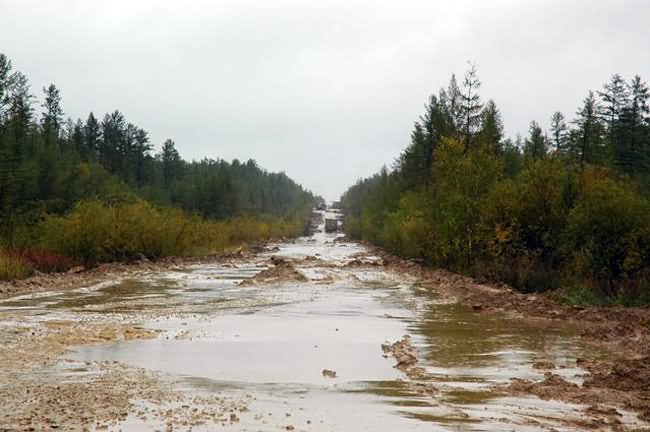
Known as the "Highway from Hell." This road runs parallel to the river Lena. During the winter it's a breeze to drive through but during the summer month with a deluge of rain, it's a mud pit.
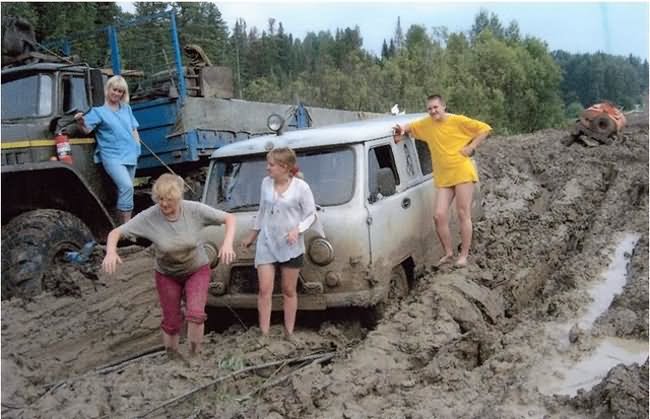
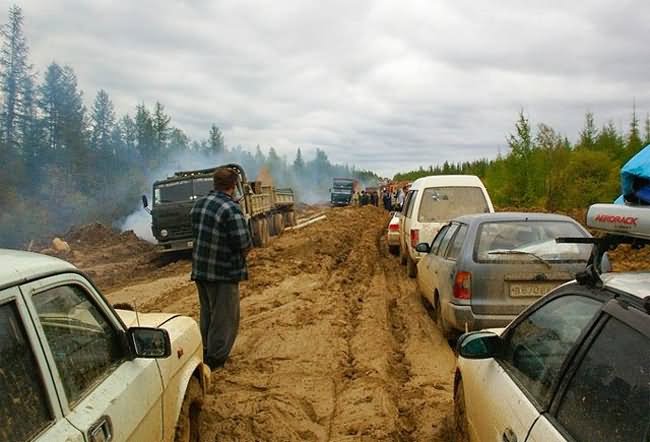
Guoliang Tunnel Road, China
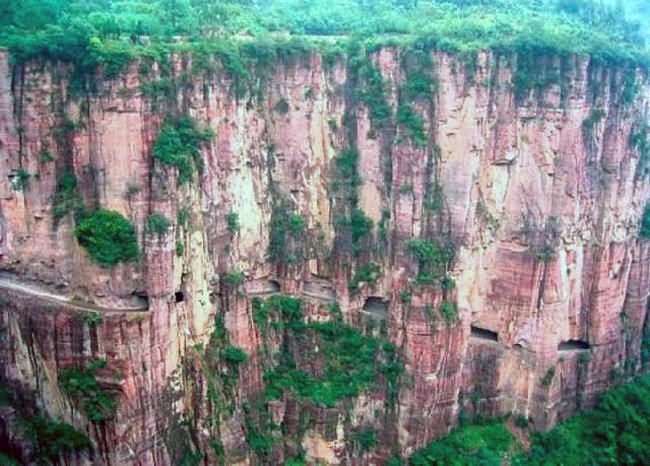
Yes, that's a tunnel road inside a mountain 200 meter long about 5 meters high and 4 meters wide. A beautiful scenic route that's dubbed, "the road that does not tolerate any mistakes." Seriously!
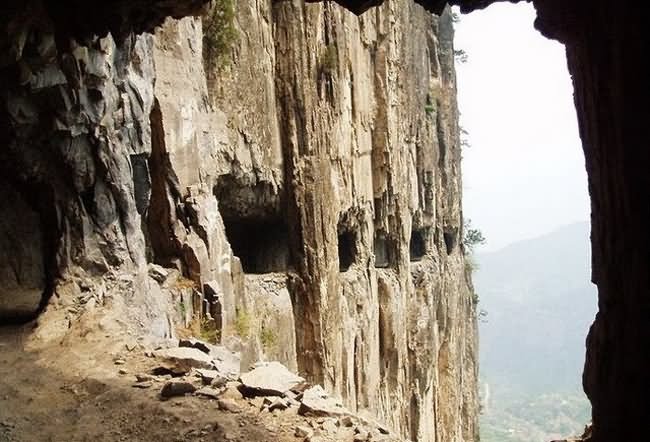
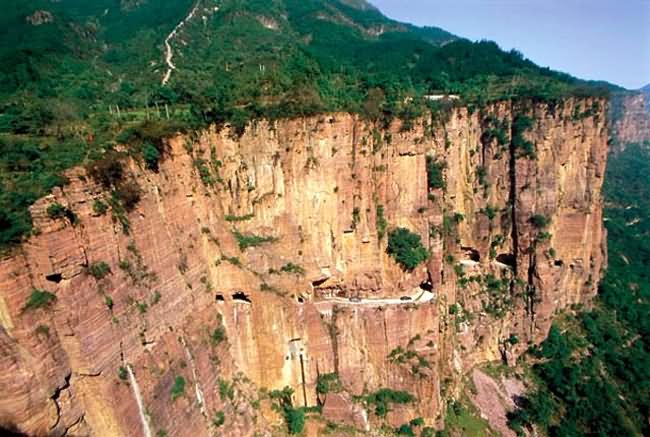
Atlas Mountains Road, Morocco
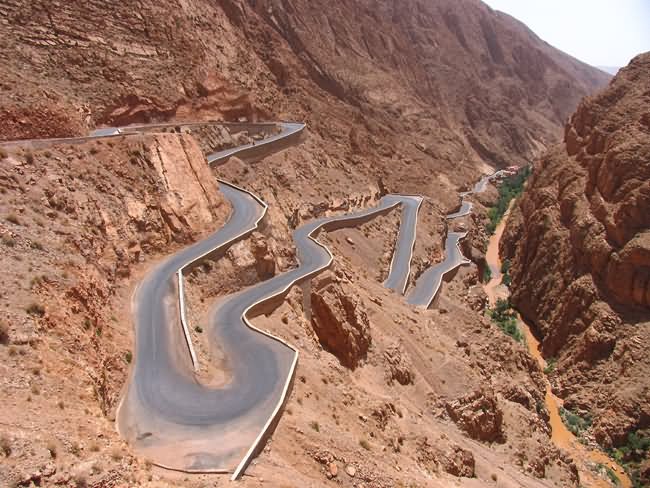
The Dades Gorge in Morocco is beautiful to look at, but not while you're driving this twisty-turvy road. You could end up being part of the Gorge.
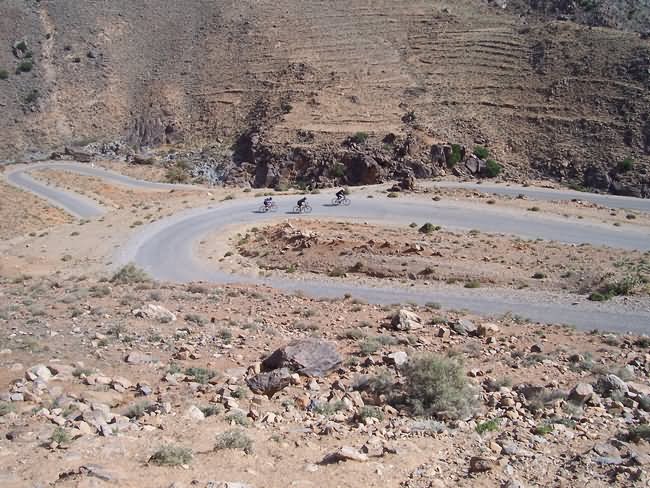
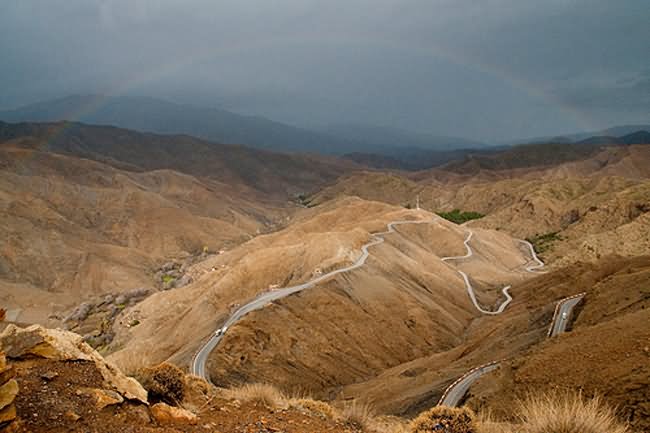
The Way to Fairy Meadows, Pakistan
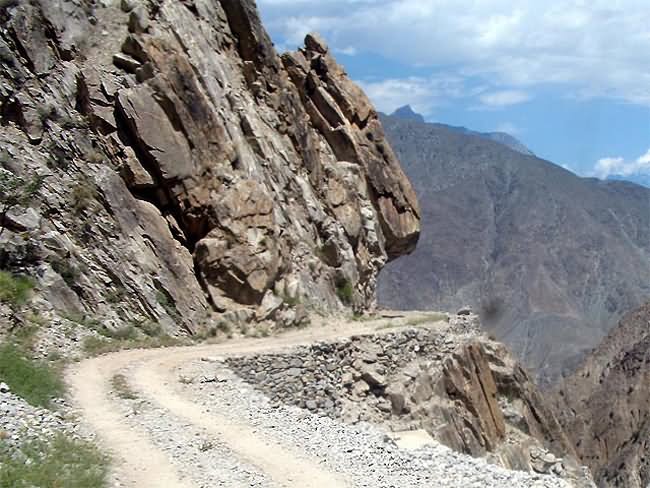
You know when they tell you not to look down when you're scared of heights, don't look down! No shoulder, no guard rail, no hope.
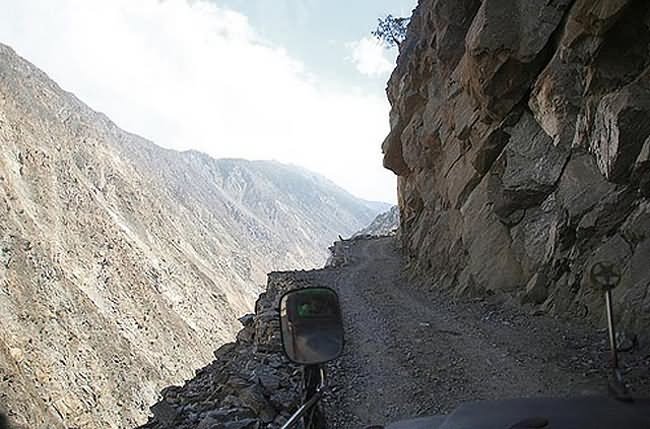
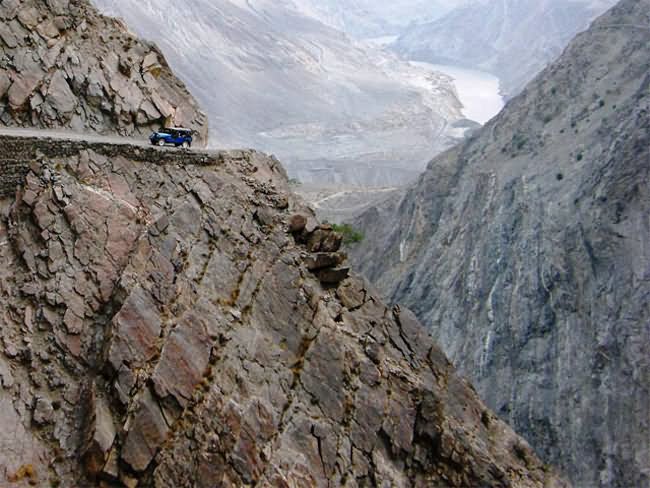
Grimsel Pass, Switzerland
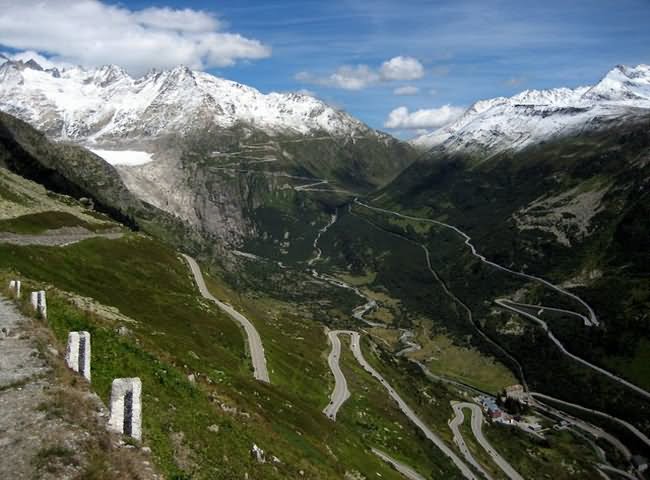
Over one mile above sea level this sloping path takes you through the Swiss mountains between the valley of the Rhone River and the Haslital valley. Guard rails and night lights but you're on a slope, don't think it's in any way safe.
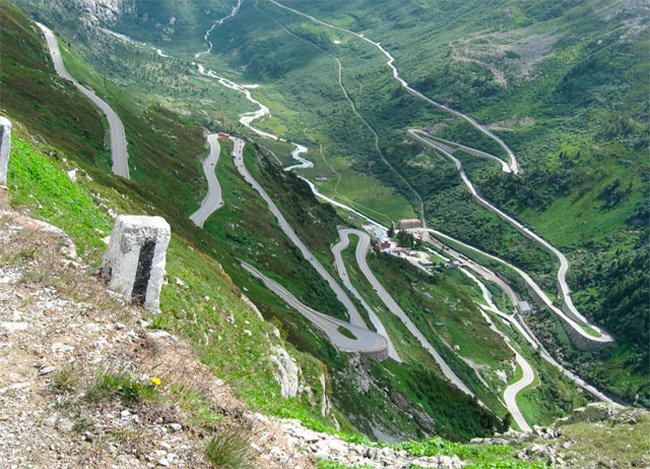
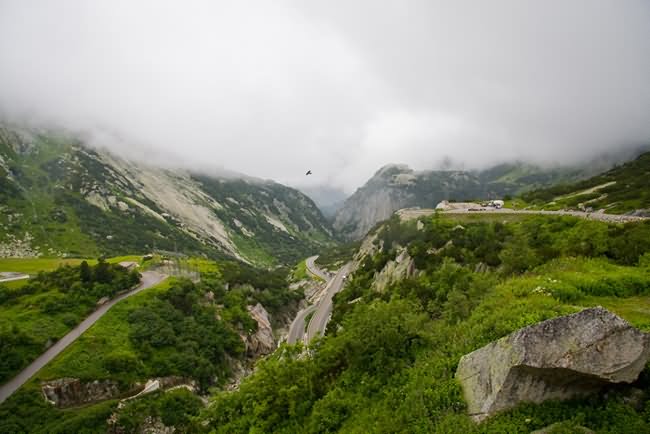
It is hard to imagine how many dangerous roads there are. When working on this post I studied about few resources to find out that there are over 100 dangerous and scary roads and these are just the most famous we've heard of. There are different factors of danger so it is really hard to say what roads are the most dangerous of all the dangerous roads in the world. But here is our list of most blood-bathing roads and the deadly routes where tonnes of accidents have happened. Do check them out and, more importantly, try to avoid them!
Stelvio Pass Road, Italy

The eastern Alps countryside of Italy are incredibly breathtaking. This zig-zag stretch of road at 1.7 miles above sea level has approximately 48 hairpin bends. It's beautiful to look at from a distance, but wouldn't be easier to fly over the Alps to get to the other side?


Trollstigen, Norway

Trollstigen translated means "Troll's Ladder." Dizzy hairpins, almost impossible to pass another car on this narrow road and then put the danger of falling rocks with steep inclines that leave you with a case of vertigo… why oh why drive here? Tourist are attracted by the beautiful 1000ft waterfall off the side of the mountain. You want to see a waterfall, fly to Hawaii. It's safer and you can get a tan.


Col de Turini, France

Who doesn't want to go to the south of France? About 20 miles on this pass is part of the Monte Carlo Rally with 34 death defying hairpins and long stretches where cars top our at over 100 miles per hour. It's considered one of the greatest driving roads of the world, but not for normal people who embrace safety first.


North Yungas Road, Bolivia

This road is also known as the "Road of Death." It's a single-lane road, so why do these trucks try to pass each other are they nuts? It's a long drop down without guardrails. There's also fog and rain to contend with including mudslides caused by moisture.


Taroko Gorge Road, Taiwan (Chungheng)

A tunnel with no lights off a cliff equals a disaster waiting to happen. Tourist love it because it passes right through a national park. At least there's a cement guard rail system.


Los Caracoles Pass, Andes

A very popular path through the Andreas Mountains between Chile and Argentina. A maze of steep inclines and hairpins without guard rails and the road is covered with snow for the most part of the year. Buy an airline ticket and fly back and forth between the two countries.


Lena Highway, Russia

Known as the "Highway from Hell." This road runs parallel to the river Lena. During the winter it's a breeze to drive through but during the summer month with a deluge of rain, it's a mud pit.


Guoliang Tunnel Road, China

Yes, that's a tunnel road inside a mountain 200 meter long about 5 meters high and 4 meters wide. A beautiful scenic route that's dubbed, "the road that does not tolerate any mistakes." Seriously!


Atlas Mountains Road, Morocco

The Dades Gorge in Morocco is beautiful to look at, but not while you're driving this twisty-turvy road. You could end up being part of the Gorge.


The Way to Fairy Meadows, Pakistan

You know when they tell you not to look down when you're scared of heights, don't look down! No shoulder, no guard rail, no hope.


Grimsel Pass, Switzerland

Over one mile above sea level this sloping path takes you through the Swiss mountains between the valley of the Rhone River and the Haslital valley. Guard rails and night lights but you're on a slope, don't think it's in any way safe.


Đăng ký:
Bài đăng (Atom)


































